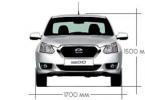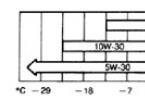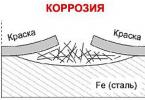One of the latest safety innovations is the Pre-Safe system, offered by the German concern DaimlerChrysler. As the name suggests, it works to anticipate a collision.
To date, cars of the brand and are equipped with it. The vehicles are equipped with three remote sensors operating on the radar principle. Two of them, with a frequency of 24 GHz, are located in the front bumper and serve an area of up to 30 m with an angular sweep of up to 80 °. Another one operating at a frequency of 77 GHz is in the radiator grille. It "drills" the space in front of the car at a distance of 150 m with a 9 ° sweep.
The sensor readings are sent to the system control unit. When the distance to an obstacle, such as the next car in front of you, is reduced to a dangerous distance, a red warning light on the dashboard lights up. If the car in front of you suddenly starts to slow down, an additional beep will sound. At the same time, Pre-Safe calculates the brake pressure required to avoid a collision. When you press the brake pedal, another electronic assistant, Brake Assist PLUS (BAS PLUS), is included in the process. However, as practice shows, drivers do not immediately react to warning light and sound signals, even repeated many times. For those who are especially inattentive, the system provides for autonomous braking of the car with a deceleration rate of up to 0.4 d. 2.6 seconds before the estimated collision moment determined by the control unit, a light and sound alarm is triggered, reminding of the possible. If the driver still does not react, after another second Pre-Safe takes control of the situation and already seriously intervenes in driving. Partial braking is performed. The system gives the driver one more second to understand the situation. If it does not brake sharply, Pre-Safe will take action to reduce the potential impact of a collision by 40%.
The system also includes passive safety elements for Mercedes-Benz vehicles. Following the warning signals, the front seats automatically assume the optimal position for the deployment of the airbags. The open side windows and sunroof close to prevent passengers from falling out of the vehicle when sliding or tipping over, and to make the side curtain airbags work more efficiently. Pre-Safe operates in the speed range from 30 to 180 km / h on the motorway, where sensors are able to distinguish between individual vehicles, or up to 70 km / h in heavy city traffic.
Heavy traffic on busy roads is in itself very unsafe and in which case the seconds count. Specifically, these seconds determine the end of someone's life. While driving on the track, the driver must be measured and attentive, moreover, under no circumstances should he be distracted by trifles. The driver can always think and get distracted from the road, and this leads to an inevitable collision, the Pre-Safe system is designed to prevent or minimize harm from a possible collision.
When this system was tested on car stimulators, 70 ordinary invited German drivers were offered to accelerate to 80 km on an ordinary suburban road and just drive. After the driver more or less adapted to this driving style, in order to distract him from the road, he was shown that there was a disaster on the road on the side of his car: cars with policemen, a certain number of people on the side of the road - all this distracted the attention of the majority. The tested drivers were so distracted that they did not react to any signs given by the car equipped with the Pre-Safe system, eventually critical braking was applied, which reduces the speed by 10 km, but still, the force of the likely collision is miniaturized by 40%.
This system uses radar technology in order to recognize danger on the road and alert the driver about it. Specifically, these radar technologies have passed unparalleled tests (cars equipped with the Pre-Safe system drove about 1 million km on ordinary roads before entering serial production). This system was also tested on car simulators and test sites. It's not a secret for anyone that accident prevention is one of the priority tasks for any self-respecting auto giant, so Mercedes-Benz is far from being the first in this case.
The Pre-Safe system is designed to save the life of the driver and not only him, it was developed by Mercedes-Benz. A car equipped with such a system lets the driver know visually and aurally about a critical approach to another car and the possibility of a collision, if the driver does not react to this, then the car itself automatically turns on partial braking (40% of the braking force of the car is used 2.6 seconds before the expected collision).
This system scans all movement within the radius of the car, it gives the driver several chances to react correctly and change the situation by braking just right. With all this, the seat belts are tightened on the driver and the passenger who sits next to each other, and airbags are inflated in the multi-profile seats, while the position of the body of passengers and the driver is fixed, everything is made so that the body of the driver and passenger takes the most harmless position, which minimizes damage during a probable accident.
Just a little more than 1 second before the collision, the car equipped with such a system begins to brake automatically, while the speed of the car that is moving towards the collision is not very significant, but still decreases, and this in turn minimizes the force of the impact.
If the driver reacted to the comments of the car, then the latter, with the help of a certain system, helps him to brake, while the braking force increases. It should be noted that before the introduction of this system, Mercedes-Benz cars were massively equipped with other safety systems, which, with the assistance of Pre-Safe, increased the safety of the car itself.
The Pre-Safe system in combination with other systems from Mercedes-Benz significantly minimizes harm during an accident or helps to prevent it. Usually 70% of drivers react to those signs, which are given by a car equipped with the Pre-Safe system, but the other 30% do not react and a collision still becomes inevitable.
Recently, the so-called. preventive (warning) systems. Preventive security system (another name - collision avoidance system) is designed to avoid a collision, and if it happened - to reduce the severity of the accident.
Depending on the design of a particular system, the following functions can be implemented in it:
- warning the driver about the danger of a collision;
- preparation of the braking system for emergency braking;
- activation of individual passive safety devices;
- partial or full automatic braking.
To implement these functions in preventive safety systems, technologies of adaptive cruise control, dynamic stabilization systems, and passive safety systems are used. A number of preventive systems that implement the automatic braking function are called emergency braking systems. Thus, the preventive safety system is an effective symbiosis of active and passive safety systems.
At present, preventive safety systems are widespread enough and are being actively implemented on passenger cars. Notable preventive security systems are:
- Pre-Sense Front, Pre-Sense Front Plus and Pre-Sense Rear from Audi;
- Pre-Safe and Pre-Safe Brake from Mercedes-Benz;
- Collision Mitigation Braking System, CMBS from Honda;
- City brake control from Fiat;
- Collision Warning with Brake Support and Forward Alert from Ford;
- Forward Collision Mitigation, FCM from Mitsubishi;
- Pre-Collision System, PCS from Toyota;
- Front assist and City emergency brake from Volkswagen;
- Collision Warning with Auto Brake and City safety from Volvo;
- Predictive Emergency Braking System, PEBS from Bosch.
Pre-Safe System from Mercedes-Benz at speeds over 30 km / h assesses the nature of the movement (speed, engine speed, etc.) and the driver's actions (steering, gas pedal, brake system). Based on the results of the assessment, the system implements the following operation algorithm:
The Pre-Safe system is always on and cannot be deactivated by the driver. Intensive work is underway to create the second generation Pre-Safe system, which is planned to be equipped with:
- side body panels that change shape before an accident;
- the seats of the front passengers moving towards the center in a side impact;
- vertical airbag between the driver and the front passenger;
- inflatable seat belts for rear passengers;
- external friction pad for emergency braking.
Pre-Safe Brake System from Mercedes-Benz uses radar to identify critical situations. It operates at a speed of 30-200 km / h and scans an area of 200 m in front of the vehicle. The system operation includes the following actions:
Action |
|
| obstacle detection (car, person) in the space in front of the car | calculating the time of a probable collision |
| 2.5 s before design collision | three beep warnings |
| 1.6 s before design collision |
partial automatic braking (40% of the maximum braking pressure); belt tension |
| the driver reacted and pressed the brake pedal | creation of maximum brake pressure |
| the driver reacted and turned into another lane | reduction of brake pressure |
| 0.6 s before the calculated collision, the driver does not respond to warnings | automatic generation of maximum brake pressure |
Pre-Safe Brake can be deactivated by the driver.
Collision Mitigation Braking System from Honda with the help of a radar at a speed of over 15 km / h and a distance of up to 100 m, it detects moving and standing cars (motorcycles). Operation of the CMBS system is similar to the Pre-Safe Brake and includes:
The CMBS system is forcibly turned off using a dedicated button.
City Safety System from Volvo uses lidar in its work. Due to the nature of this sensor, the scope of the system is at speeds up to 30 km / h and a distance of up to 10 m. Unlike other preventive systems, City Safety does not warn the driver of a possible collision. The system is triggered late and rudely enough that drivers do not rely on it in every driving situation. The City Safety system is represented by the following preventive functions:
Action |
|
the vehicle approaches an obstacle at a speed that could lead to an accident; The driver does not react to an obstacle |
preparing the brake system for braking (activating the pump for a few hundredths of a second, bringing the pads to the discs); reduction of the torque value (via the engine control unit) |
| the driver does not react to an obstacle | automatic braking |
| the driver reacts to an obstacle (movement of the steering wheel, brake pedal) | automatic braking is not activated |
| the driver has not pressed the brake pedal hard enough | activation of the EVA (Emergency Brake Assist) system and the creation of maximum braking force |
The system can be turned off, but will automatically turn on with every new ride.
Switch off the ignition.
Press and hold the electric parking brake knob for at least ten seconds. engage first gear. shift the transmission to the "P" position. Contact a qualified specialist workshop. The yellow warning light and the red indicator light are on. The electric parking brake is defective.
Release the electric parking brake manually. Or: Cars with automatic transmission: more.
If the parking brake is electric. Do not continue driving.
Contact a qualified specialist workshop. The red indicator light flashes and the yellow warning light is on. The electric parking brake is defective.
Switch the ignition off and back on.
Release the electric parking brake manually.
Switch the ignition off and back on.
Apply the electric parking brake manually.
If the red control lamp continues You cannot continue driving.
Protect the vehicle from rolling away more.Cars with manual transmission: engage first gear. Cars with automatic transmission: shift the transmission to the "P" position. Turn the front wheels towards the curb. Contact a qualified specialist workshop. The yellow warning light is on. The red indicator light flashes for about ten seconds after the electric parking brake is applied or released. After that, the lamp goes out or continues to burn. The electric parking brake is defective.
Switch the ignition off and back on.
Apply the electric parking brake.
Cars with manual transmission: engage first gear.
shift the transmission to the "P" position. Contact a qualified specialist workshop.If the electric parking brake is not Vehicles with manual transmission (with automatic emergency release function): insert the seat belt into the seat belt buckle and press harder on the accelerator pedal when starting off.
Cars with automatic transmission: release the electric parking brake automatically more.If electric parking brake Contact a qualified specialist workshop.
The yellow warning light is on. When the electric parking brake is applied or released manually, the red indicator lamp flashes. The electric parking brake is defective. The electric parking brake is not manually applied.
Cars with manual transmission: engage first gear.
Cars with automatic transmission: shift the transmission to the "P" position. Contact a qualified specialist workshop. The yellow warning light is on. The electric parking brake is defective.Switch off the ignition.
Press and hold the electric parking brake knob for at least ten seconds. engage first gear. shift the transmission to position. Contact a qualified specialist workshop. The yellow warning light and the red indicator light are on. The electric parking brake is defective.
Release the electric parking brake manually. Or: Release the electric parking brake automatically.
If the parking brake is electric. Do not continue driving.
Contact a qualified specialist workshop. The red indicator light flashes and the yellow warning light is on. The electric parking brake is defective.
Switch the ignition off and back on.
Release the electric parking brake manually.
Switch the ignition off and back on.
Apply the electric parking brake manually.
If the red control lamp continues You cannot continue driving.
Protect the vehicle from rolling away. Cars with manual transmission: engage first gear. Cars with automatic transmission: shift the transmission to position. Turn the front wheels towards the curb. Contact a qualified specialist workshop. The yellow warning light is on. The red indicator lamp flashes for approximately ten seconds after the electric parking brake is applied or released. After that, the lamp goes out or continues to burn. The electric parking brake is defective.
Switch the ignition off and back on.
Apply the electric parking brake.
If the electric parking brake Cars with manual transmission: engage first gear.
Cars with automatic transmission: shift the transmission to position. Contact a qualified specialist workshop.If the parking brake is electric Contact a qualified specialist workshop.
The yellow warning light is on. When the electric parking brake is applied or released manually, the red indicator lamp flashes. The electric parking brake is defective. The electric parking brake is not manually applied.
Cars with manual transmission: turn off the ignition.



